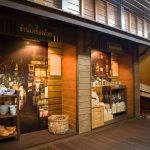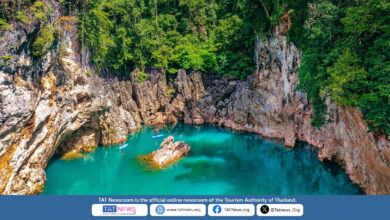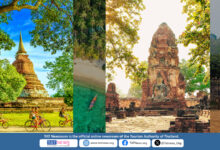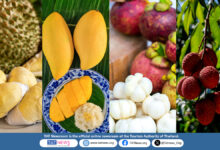Thailand’s three provinces Samut Prakan, Chanthaburi and Trat share a common history with France. After the 1893 Paknam crisis, French troops occupied Chanthaburi and Trat provinces. The ensuing 14-year occupation proved very influential in the old ‘Chanthaboon’ district where buildings feature European-style windows, arcades, and wooden balconies similar to those built across French Indochina.
Paknam, Samut Prakan
The Phra Chulachomklao Fort stands tall in Phra Samut Chedi district, Samut Prakan. Built between 1884 and 1893 by King Chulalongkorn the Great in the European style, the Fort has since been modernised and is now a museum. Located just under a monument dedicated to the King dressed in a navy commander’s uniform, the museum contains an exhibition about the Paknam incident and Franco-Siamese War of 1893. The King Rama V Fortress Historical Park opposite the museum displays the information of the war and the development of the Royal Thai Navy.
Chanthaburi
Chanthaburi’s old ‘Chanthaboon’ district still shows French architectural influences. At least a dozen of these historic houses survived modernisation. Many are now hip coffee shops, art galleries, restaurants and boutique hotels. The nearby Baan Phokabarn houses an information centre and small museum with old images depicting this bygone era.
The impressive Cathedral of the Immaculate Conception, started during the brief French occupation, is over the river from the Chanthaboon riverside community. It was finished two years after France withdrew from the province and is one of the largest Catholic churches in Thailand. While the outside façade is rather austere with its dark greyish-brown colour, it contrasts with the exuberant gothic interior style. Its vaulted ceiling, wall paintings in trompe-l’oeil and stained glass were all manufactured in France. The church is an important hub for Chanthaboon’s Vietnamese Catholic community who emigrated there during the French colonial period.
Suan Ban Kaeo Palace in Ta Chang district is another important example of the European style from the early 20th century. The royal residence of Queen Rambhai Barni, a palace comprised of a cluster of wooden pavilions (chalets), was constructed in a typical European style.
An ancient French prison is open to visitors at the opposite of the elegant palace. Khuk Khi Kai prison, just before Laem Sing Beach, was built to hold Thais who rebelled against the French occupation in Chanthaburi. A seven-metre high, square-shaped prison was built with bricks each measuring 4.40 metres per side. The walls were perforated for ventilation, but the porous roof housed a chicken coop, where the poultry dropped excrement on prisoners as a sort of torture.
Trat
Thailand’s easternmost province also offers French-related heritage further along the coast of the Gulf of Thailand, starting in the city centre. The historical town (Bang Phra district) also exhibits a collection of 100-year-old wooden houses; some built during the French occupation. The former house of the French Governor in Trat (Resident Kampot), located on Luk Mueang Road, is renovated. It is a rather simple two-storey white building that is painted and contrasts with the more elaborate former Trat City Hall, today the Trat Museum.
The beautifully restored Trat Museum’s shape and architecture, with its large wooden pediment and pillars, takes its inspiration from European houses in Southern Thailand. Here, visitors can enjoy an excellent overview to Trat history. It evocates a memorable naval battle between Thailand and France in 1941. Inside the museum are pictures and documents remembering the battle between Thai and French naval forces, conducted by French warships in support of a land offensive against Thai troops on the Cambodian border.
French influence is mostly visible today in the number of tourists who spend their days along the Gulf of Thailand, or in transit on their way to nearby Cambodia. It is happily a much more peaceful cohabitation than 100 years ago!
About the Author
This is the fourth of the five-part story on European architectural heritage in Thailand written by Luc Citrinot, a freelance journalist and consultant in tourism and air transport with over 20 years’ experience. The views and opinions expressed in this article do not necessarily represent those of the Tourism Authority of Thailand (TAT). Therefore, TAT is not responsible for the accuracy or reliability of information written by this writer.
Disclaimer
Historical information contained in this article is based on Thai history books and French colonial history books. This article intends to offer perspectives on European architectural influence and French flairs on the Gulf of Thailand for the benefit of travellers in search for historical attractions, and so it should not be considered as an historical fact of any kind.















